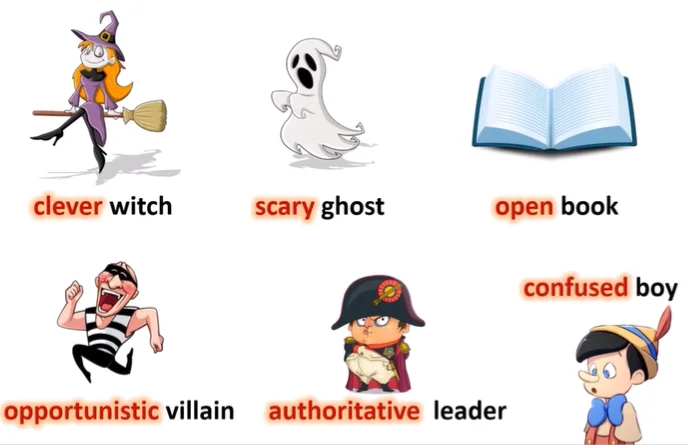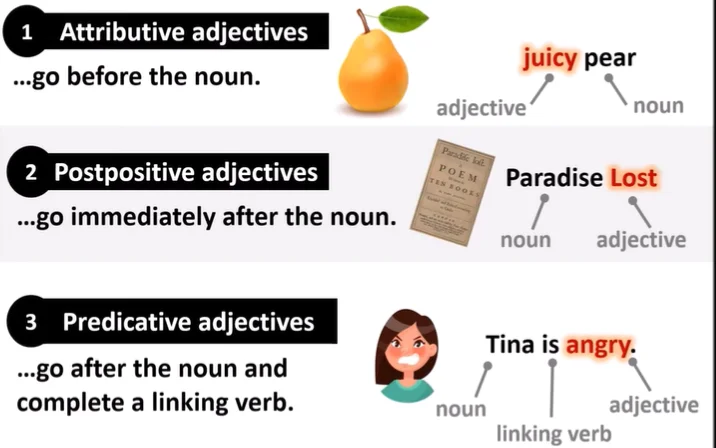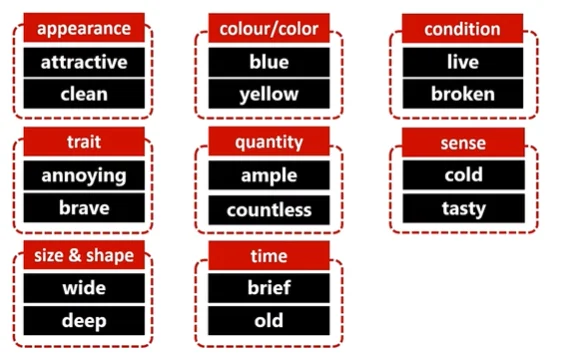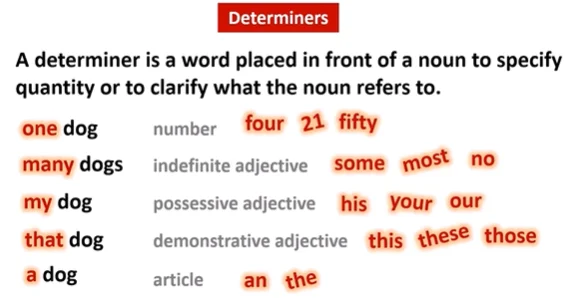Adjectives are one of the 9 parts of speech given below:
Definition
Adjectives are words that describe nouns (persons, places, things) or pronouns. For example, The words ahead of adjectives are nouns, and they are being modified by adjectives.

3 Types
We can categorize adjectives into these three types.
Attributive Adjectives
Attributive adjectives, like the ones, we’ve seen so far, go before the noun. So, remember juicy pear. Here’s our adjective, and it sits before the noun it modifies.
Examples
| No. | Examples | Adjectives | Nouns |
| 1. | A juicy pear | “Juicy” is the adjective | “Pear” is the noun |
| 2. | Red tomatoes | “Red” is the adjective | “Tomatoes” is the noun |
| 3. | Fatty plums | Fatty | plums |
| 4. | Expensive onion | Expensive | onion |
| 5. | Clever witch | Clever | witch |
| 6. | Scary ghost | Scary | ghost |
| 7. | Authoritative leader | Authoritative | leader |
| 8. | Opportunistic villain | Opportunistic | villain |
| 9. | Confused boy | Confused | boy |
| 10. | Sweet dish | Sweet | dish |
Post-positive Adjectives
And, they go immediately after the noun. So, Paradise Lost is a poem by John Milton. This time our noun is in front, and our adjective goes immediately afterward.
Let’s put up some examples:
| No. | Examples | Nouns | Adjectives |
| 1. | Time immemorial | Time | immemorial |
| 2. | Body lovely | Body | lovely |
| 3. | People trustworthy | People | trustworthy |
| 4. | Something funny | Something | funny |
| 5. | Nothing costly | Nothing | costly |
| 6. | Someone sinful | Someone | sinful |
This is an excellent opportunity to point out that adjectives can alter pronouns as well as nouns, as shown in the previous examples.
Let’s look at more examples:
Remember ‘clever witch’? Well, we could say “clever one,” and in this case, we have an adjective modifying a pronoun. Remember, adjectives can describe nouns or pronouns.
Predicative Adjectives
Adjectives can also be predicative adjectives, and they go after the noun and complete a linking verb. For example:
- Tara is angry.
‘Tara‘ is our noun. “is“, is a linking verb, and here is our adjective=angry completing the linking verb.
Let’s look at another example:
- She seems frustrated.
“She” is a pronoun, “seems” is our linking verb, and “frustrated” is our adjective.

Categories
It might be useful to think of adjectives as describing words, and they will usually fit into one of these categories:
| Appearance | Color | Condition | Trait | Quantity | sense | Size | Time | Shape |
| attractive | red | live | brave | ample | cold | small | old | round |
| clean | blue | broken | annoying | countless | tasty | large | brief | square |
| beautiful | yellow | hot | wise | enough | loud | long | new | oval |
| ugly | black | soft | foolish | less | slow | tiny | latest | circle |

As you can imagine, there are thousands of adjectives. Keep these two: annoying and broken. Let’s put them in a more useful place on the page.
These adjectives are participles.
Here is a definition for participle: a participle is a word formed from a verb that can be used as an adjective. Annoying comes from the verb “to annoy”, and broken comes from the verb “to break.” So, we have a whole page on verbs. “Annoying” is a present participle, but “broken” is a past participle.
All present participles end –“ing.” Past participles are harder.
- Some end –ed
- Some –nd
- Some –‘nt’
- Some end –en
- Some end just –n
- Some end –t
Let’s look at some examples:
Boiling water
Well, this is our present participle, and this is our noun.
Written word
This is our past participle, and this is our noun.
Determiners
A determiner is a word placed in front of a noun (that sounds a bit like an adjective) to specify quantity, or to clarify what the noun refers to. So, one dog. This is a number, this is about quantity. Other numbers might be Four, Twenty, or Fifty. It doesn’t matter what the number is. It’s a determiner.
Many dogs. Again, this is about quantity. A word like “many” is categorized as an indefinite adjective in classical grammar. Examples are some, most, and, no; some dogs, most dogs, no dogs. Again, it’s about quantity. My dog, now, in traditional grammar, “my” would be classified as a possessive adjective. Other examples would be his, your, or our.
That dog. In traditional grammar, this would be a demonstrative adjective. This, these, and those are other examples. A dog “A” is classified as an article, and in traditional grammar, articles are also classified as adjectives. But other examples are an and the. Particularly, if you’re learning a foreign language, you may see those terms described as adjectives, but in contemporary grammar, they are described as determiners.
- Remember, we can have attributive adjectives that go before the noun.
- You can have post-positive adjectives that go immediately after the noun.
- You can have predicative adjectives that complete a linking verb.
- So, an adjective is a word that describes a noun or a pronoun.



